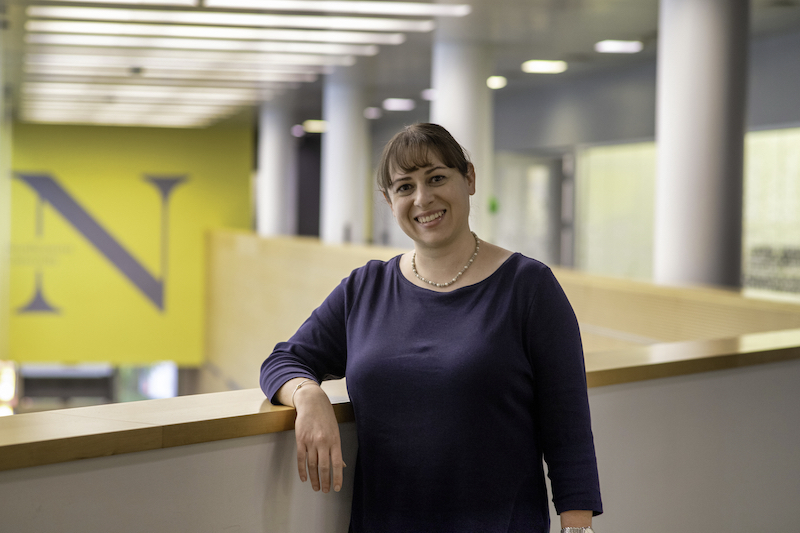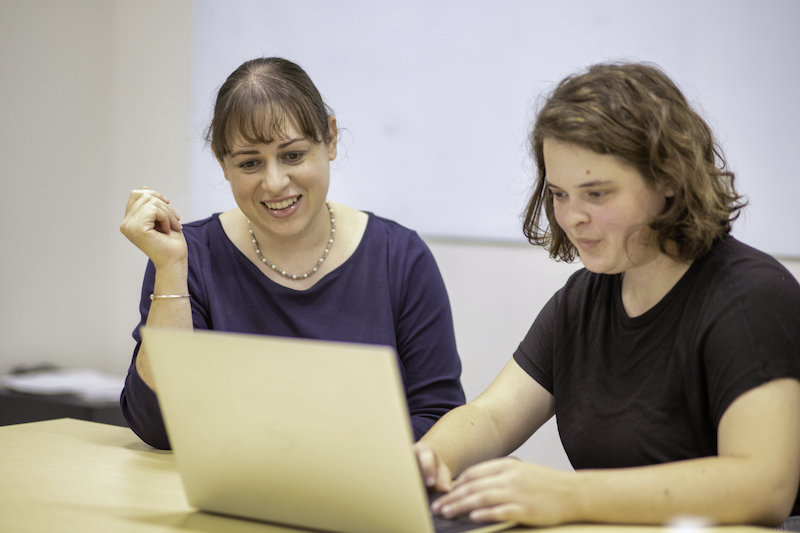From astronomy and physics to data visualization: How Michelle Borkin won the top award in her field
Author: Milton Posner
Date: 10.28.21
Examining the many facts on Michelle Borkin’s resumé inevitably provokes one question:
How did a lifelong astronomy devotee, one who spent several years earning a doctoral degree in applied physics, just win an uber-prestigious data visualization award?
 Michelle Borkin
Michelle Borkin
On October 26, the IEEE Visualization and Graphics Technical Committee (VGTC) bestowed their first-ever Significant New Researcher Award on the Khoury College of Computer Sciences professor. The award recognizes important data visualization research conducted within seven years of the recipient’s most recent degree.
“I’m thrilled that Professor Borkin has been awarded the IEEE VGTC award for early career researchers,” Interim Dean Alan Mislove said. “This is the highest award that junior faculty members can receive in the field of data visualization.”
The committee’s recognition of Borkin’s “work on visualization memorability, visualization evaluation methods, and their application to astrophysics and medicine” speaks to the unpredictable, interdisciplinary path she has carved out in the last 15 years. It’s a path that switched academic tracks without compromising Borkin’s intellectual passions, one shaped by collaborations with colleagues and students, and one with plenty of chapters left to write.
Computer science, then astrophysics
“I was extremely fortunate to have early exposure to computer science, as my father has a PhD in the subject,” Borkin recalled. “So I grew up with a personal computer, reading BASIC and playing games. My parents always supported my interests. However, my passion for so many sciences—from geology to archaeology to astrophysics—captured my attention.”
Astrophysics took the wheel for a while, forming the basis of Borkin’s undergraduate studies.
However, during a coffee chat aimed at finding her an astronomy project, her undergraduate advisor mentioned a talk she’d given about challenges in astronomy data analysis and visualization. A radiologist in the audience at the event bounded up and started chatting about the similarities between medical and astronomical data analysis.
An immediately intrigued Borkin, to her advisor’s confusion, zeroed in on the idea as a potential thesis, proposing that she “learn the radiology software, the algorithms, and the image processing, and see if we can use this to better analyze and visualize our astronomy data.”
“At the time it was pretty risky, because it could have failed,” Borkin explained. “But thank goodness it didn’t. I was hooked.” She recounted that pivotal change in direction: “I withdrew my astronomy grad school applications and took a couple of years between college and grad school to be a research assistant and figure out, ‘What is this thing called data visualization?’”
Around this time, her research advisor sent her to her first IEEE VIS conference, where she was thrilled by the scope and breadth of the field and its community. Fifteen years later, her contributions have helped shape the field.
Data visualization research and education
Most of Borkin’s research, and the impetus for the IEEE VGTC award, focuses on visualization evaluation methodologies and evaluation studies at the intersection of cognition, perception, vision, and data visualization.
“One area of work where I’ve made a significant contribution is better understanding how people see, interpret, and remember visualizations,” she explained. “Two of my most impactful papers were about what makes a visualization memorable, which has implications for how we learn and communicate. It’s really important for journalism, education, and scientific communication.”
Borkin recommends that visualizations be unique, clean, easy to read, and well-titled, with labeled axes and (preferably visual) annotations to highlight key takeaways.
“This is what I teach my DS 4200 undergrads,” Borkin said, referring to her “Information Presentation and Visualization” course. “These were loose qualitative guidelines, but the work I did with my collaborators pinned them down with actual data, confirmed them, and explained why.”
Mislove added that Borkin’s research and philosophy made her an integral part of Khoury College, noting that “her data visualization class is one of the most popular in the college, and her service-learning approach is both innovative and well-aligned with the college and university’s experiential learning mission.”
That experiential component is present in all aspects of Borkin’s career. It manifests in the classroom, where her service-learning-based curriculum helps students learn more effectively, impresses on them the value of their work on their communities, and inspires Borkin’s own research.
It also manifests in the research itself, where she develops theory, crafts software and tools, and places them in the hands of practitioners. The award—which was also separately awarded to the University of Edinburgh’s Benjamin Bach—marks the reach and significance of that work.
“Right out of the blue, I get this email: ‘Congratulations!’” Borkin said. “I’m really shocked and surprised and honored.”
Impact on software, astronomy, and medicine
Fifteen years after the decisive coffee chat with her advisor, nothing and everything has changed for Michelle Borkin.
Her research is a unique blend of data visualization, software, astronomy, and medicine. She’s working to improve clinical decision support systems for hospitals while simultaneously serving as visualization lead for Glue, a versatile data analytics tool employed in astronomy by the James Webb Telescope, which will replace the vaunted Hubble.
READ: Novel framework for implementing design studies wins best paper at CHI 2020
Some of Borkin’s graduate students came to work with her because of her research profile. Others, she says, enlighten her and challenge her to consider new research areas. Laura South made her think more about accessibility. Uzma Haque Syeda pushed her to think about visualization for social good.
 Michelle Borkin and Laura South
Michelle Borkin and Laura South
“The research I’m getting this award for is near and dear to my heart, and it is the core of the work I do now with my graduate students,” Borkin noted. “Now that I’m lucky to be an assistant professor with a growing lab and wonderful, brilliant graduate students, I’ve been able to expand it.”
After winning the most prestigious award her field offers to young researchers, Borkin reflected on her gratitude for the academic home she’s found at Khoury College, one based on the interdisciplinary philosophy that has infused her career.
“I’ve flourished in an environment that supported interdisciplinary research,” Borkin said. “It accepted me coming in with a different background, embraced my diversity, and supported me as I grew into a professor.”
Subscribe to the Khoury College newsletter
The Khoury Network: Be in the know
Subscribe now to our monthly newsletter for the latest stories and achievements of our students and faculty